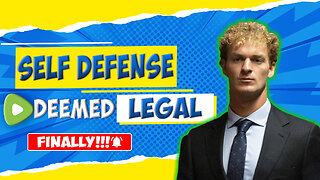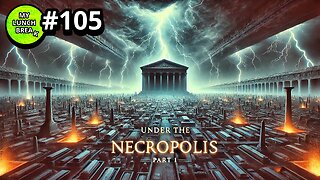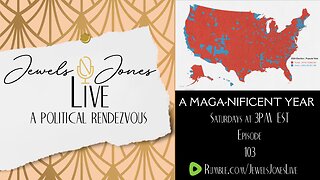Premium Only Content

What Would Happen in the Event of a Nuclear Attack
The dark side of history: https://thememoryhole.substack.com/
The War Game is a 1966 British pseudo-documentary film that depicts a nuclear war and its aftermath.[1] Written, directed and produced by Peter Watkins for the BBC, it caused dismay within the BBC and also within government, and was subsequently withdrawn before the provisional screening date of 6 October 1965.[2] The corporation said that "the effect of the film has been judged by the BBC to be too horrifying for the medium of broadcasting. It will, however, be shown to invited audiences..."[3]
The film eventually premiered at the National Film Theatre in London, on 13 April 1966, where it ran until 3 May.[4] It was then shown abroad at several film festivals, including the Venice one where it won the Special Prize. It also won the Academy Award for Best Documentary Feature in 1967.[5][6]
The film was eventually televised in Great Britain on 31 July 1985, during the week before the fortieth anniversary of the Hiroshima bombing, the day before a repeat screening of Threads.[7]
Synopsis
In an opening voiceover, the omniscient narrator explains that Britain's nuclear deterrent policy "threatens a would-be aggressor with devastation from Victor and Vulcan Mk II nuclear bombers of the V bomber force" of the Royal Air Force. Due to the number of bases for this force, as well as major civilian targets in cities, it is claimed that the United Kingdom has more potential targets than any other country in the world. In a crisis, the narrator predicts that the V Bomber force would be dispersed throughout the country, increasing the number of targets.
On Friday, 16 September,[a] the UK declares a state of emergency. The Chinese have invaded South Vietnam, and the United States has authorised their forces there to use tactical nuclear warfare. The Soviets and East Germans threaten to invade West Berlin if the U.S. does not withdraw its decision. In the county of Kent, in the southeast of England, emergency committees of city and borough councillors are faced with receiving a mass evacuation of children, mothers, and the infirm. Homeowners are forced to billet and feed the arrivals under threat of imprisonment, and unoccupied homes are requisitioned. Ration cards are issued. The following day, civil defence distributes a booklet detailing the hazards of nuclear war. It is revealed that the booklet had been available for some years, but "did not sell very well." The emergency siren system is tested; the narrator estimates that by the time an incoming attack could be confirmed by the system, there would remain some 2.5–3 minutes, or in the case of a submarine attack, under thirty seconds, until impact. There is a run on construction supplies, and price gouging puts them out of the reach of many citizens.
Conventional warfare breaks out between NATO and Warsaw Pact forces on the inner German border. Two U.S. Army divisions attempt to fight their way into Berlin, but Soviet and East German forces overwhelm them. U.S. President Lyndon B. Johnson authorises NATO commanders to use their tactical nuclear weapons, and they do so, firing Honest John missiles. The film remarks that many Soviet strategic IRBMs are believed to be liquid-fueled and stored above ground, making them extremely vulnerable. It hypothesises that the Soviet Union would be obliged to fire all of them in a very early stage of a nuclear exchange to avoid their destruction.
On 18 September a doctor, now on the staff of an emergency medical aid unit, pays a house call to a family in Canterbury, Kent, along with two civil defence workers. At 9:13 am the air-raid sirens start to wail in the distance, followed by a klaxon horn from a police car. The family and visitors frantically try to move furniture into a makeshift shelter. At 9:16 am a one-megaton Soviet thermonuclear warhead overshoots Manston Airfield, 12 miles away, and airbursts six miles away. One of the defence workers is bringing a boy in from the yard, and both are struck by the heat wave at a distance to cause third-degree burns, and "melting of the upturned eyeball." Inside, furniture ignites, and the people inside frantically try to put out the fires until the shock front hits the house.
The film then briefly quotes two bishops, who state that the faithful must "learn to live with, though need not love, the nuclear bomb". It shows a small child suffering severe retinal burns from a detonation 27 miles away. His father carries him inside and the family hide under a table as their house trembles, presumably from the blast wave near Canterbury, then from an explosion at Gatwick Airport, Sussex, 41 miles away. Rochester burns from a missile that exploded off-course on its way to London Airport. Firemen take severe casualties from the >100 mph winds of the firestorm. As the firestorm's center rises to 800 °C, and it consumes oxygen and replaces it with methane, carbon monoxide, and carbon dioxide, responders and civilians alike collapse from heat stroke and the gases and die where they stand. By 10:47 am, British V bombers inflict the same devestation on the Soviet Union.
In the aftermath, medical services struggle to cope. The narrator reports that each surviving doctor would be faced with at least 300 casualties, as patients are triaged. The worst affected are left to die alone in agony. Armed police shoot some of these triaged victims. PTSD and other conditions are widespread, and the police, civil defence, and British Army lose several of their number to the strain.[citation needed] In Kent, which is described as "lightly hit", there are far too many dead to bury, with the authorities instead burning bodies in abandoned buildings. Wedding rings are collected from the dead in buckets for later identification, a practice seen after the Bombing of Dresden during the Second World War. One woman reports that her family must live with only the water in a bathtub, using it for drinking, cooking, and bathing. As the film notes happened in Hiroshima and Nagasaki, many become "apathetic and profoundly lethargic, people living often in their own filth."
As food supplies dwindle, authorities in Kent eventually withhold food for only those maintaining law and order, with all surviving police being armed. Hunger riots turn violent. Two days later, anti-authority elements seize a police ammunition truck, and seize and pilfer from a government food control centre. As from the outbreak of war, civil disturbance and the obstruction of government officers are now capital offences, two men, one of whom is the father seen earlier rescuing his blinded child, are shown being executed by firing squad for such acts. The initial stages of scurvy set in. The film ends in a refugee compound in Dover on December 25, during the first Christmas since the attack. Various war victims are shown, one of whom is a boy who the narrator reports will be bed ridden for seven years before dying due to radiation, and another of whom is a pregnant girl who is unlikely to successfully deliver her child. Bewildered and traumatised orphan children are asked what they want to grow up to be, and they answer that they "don't want to be nothing" or simply not answer at all. The narrator argues that there is a silence in the contemporary press regarding the dangers of nuclear war, even as the stockpile of nuclear weapons continues to grow. "Silent Night" plays over the closing credits.
Style
The story is told in the style of a news magazine programme. It wavers between a pseudo-documentary and a drama film, with characters acknowledging the presence of the camera crew in some segments and others (in particular the nuclear attack) filmed as if the camera was not present. The combination of elements also qualifies it as a mondo film. It features several different strands that alternate throughout, including a documentary-style chronology of the main events,[8] featuring reportage-like images of the war, the nuclear strikes, and their effects on civilians; brief contemporary interviews, in which passers-by are interviewed about what turns out to be their general lack of knowledge of nuclear war issues; optimistic commentary from public figures that clashes with the other images in the film; and fictional interviews with key figures as the war unfolds.
The film features a voice-over narration[9] that describes the events depicted as plausible occurrences during and after a nuclear war. The narration attempts to instil in the viewing audience that the civil defence policies of 1965 have not realistically prepared the public for such events, particularly suggesting that the policies neglected the possibility of panic buying that would occur for building materials to construct improvised fallout shelters.
The public are generally depicted as lacking all understanding of nuclear matters with the exception of a character with a double-barrelled shotgun who successfully implemented the contemporary civil defence advice, and heavily sandbagged his home. The film does not focus on individual experiences, but rather the collective British population, who rely on government preparations and are not fully convinced of the dangers of nuclear war until the final hours before the attack.
Production
Of his intent, Peter Watkins said:[10]
... Interwoven among scenes of "reality" were stylized interviews with a series of "establishment figures" – an Anglican Bishop, a nuclear strategist, etc. The outrageous statements by some of these people (including the Bishop) – in favour of nuclear weapons, even nuclear war – were actually based on genuine quotations. Other interviews with a doctor, a psychiatrist, etc. were more sober, and gave details of the effects of nuclear weapons on the human body and mind. In this film I was interested in breaking the illusion of media-produced "reality". My question was – "Where is 'reality'? ... in the madness of statements by these artificially-lit establishment figures quoting the official doctrine of the day, or in the madness of the staged and fictional scenes from the rest of my film, which presented the consequences of their utterances?
To this end, the docudrama employs juxtaposition by, for example, quickly cutting from the scenes of horror after an immediate escalation from military to city nuclear attacks to a snippet of a recording of a calm lecture by a person resembling Herman Kahn, a renowned RAND strategist, hypothesizing that a counterforce (military) nuclear war would not necessarily escalate immediately into countervalue-targeted (i.e. civilian-targeted) nuclear war. The effect of this juxtaposition is to make the speaker appear out of touch with the "reality" of rapid escalation, as depicted immediately before his contribution.
The film was shot in the Kent towns of Tonbridge, Gravesend, Chatham and Dover. The cast was almost entirely made up of non-actors, as was Watkins' preference,[11] casting having taken place via a series of public meetings several months earlier. Much of the filming of the post-strike devastation was shot at the Grand Shaft Barracks, Dover. The narration was provided by Peter Graham with Michael Aspel reading the quotations from source material.
Release
The War Game itself finally saw television broadcast in the United Kingdom on BBC2 on 31 July 1985, as part of a special season of programming entitled After the Bomb (which had been Watkins's original working title for The War Game).[12] After the Bomb commemorated the 40th anniversary of the bombing of Hiroshima and Nagasaki.[13] The broadcast was preceded by an introduction from Ludovic Kennedy.[14]
On 27 August 1968, nearly 250 people at a peace rally in the Edwin Lewis Quadrangle in Philadelphia, attended the screening of the film sponsored by the Pennsylvania Coalition.[15] Like the United Kingdom, the film was also banned from National Educational Television in the United States due to its theme.
Reception and legacy
The film holds a Rotten Tomatoes rating of 93% based on 14 reviews, with an average score of 8.46/10.[16]
Roger Ebert gave the film a perfect score, calling it "[o]ne of the most skillful documentary films ever made." He praised the "remarkable authenticity" of the firestorm sequence and describes its portrayal of bombing's aftermath as "certainly the most horrifying ever put on film (although, to be sure, greater suffering has taken place in real life, and is taking place today)." "They should string up bedsheets between the trees and show "The War Game" in every public park" he concludes, "It should be shown on television, perhaps right after one of those half-witted war series in which none of the stars ever gets killed."[17] David Cornelius of DVD Talk called it "one of the most disturbing, overwhelming, and downright important films ever produced." He writes that the film finds Watkins "at his very best, angry and provocative and desperate to tell the truth, yet not once dipping below anything but sheer greatness from a filmmaking perspective [...] an unquestionable masterpiece of raw journalism, political commentary, and unrestrained terror."[18]
Accolades
The film won the 1967 Academy Award for Best Documentary Feature.[19]
In a list of the 100 Greatest British Television Programmes drawn up by the British Film Institute in 2000, voted for by industry professionals, The War Game was placed 27th. The War Game was also voted 74th in Channel Four's 100 Greatest Scary Moments.[20]
See also
List of nuclear holocaust fiction
Nuclear weapons and the United Kingdom
Nuclear weapons in popular culture
Survival film, about the film genre, with a list of related films
Threads, a 1984 British docudrama about nuclear war
The Day After, a 1983 US film about nuclear war and its aftermath
When the Wind Blows, a 1986 animated film about nuclear war
Notes
Presumably 1966; this date did not appear again until 1977.
References
MUBI
Chapman, James (2006). "The BBC and the Censorship of The War Game". Journal of Contemporary History. 41 (1): 84. doi:10.1177/0022009406058675. S2CID 159498499.
"BBC film censored? (Parliamentary question asked in the House of Commons by William Hamilton MP about the TV film 'The War Game')". The National Archives (CAB 21/5808). 2 December 1965.
The Guardian, 1–3 April 1966
1967|Oscars.org
Sean O'Sullivan, "No Such Thing as Society: Television and the Apocalypse" in Lester D. Friedman Fires Were Started: British Cinema and Thatcherism, p,224
Heroes By John Pilger pg 532, 1986, ISBN 9781407086293
Film Festival: Two Tours de Force: 'The War Game' Catalogues Lists of Horrors – The New York Times
The War Game (1967) – Turner Classic Movies
"The War Game". Peter Watkins. 24 September 1965. Retrieved 6 November 2018.
The Concise Routledge Encyclopedia of the Documentary Film – Google Books (pgs.973-75)
"BBC – The War Game". BBC.
"The War Game Part 2". Peter Watkins. 24 September 1965. Retrieved 6 November 2018.
"wed play season nine". Startrader.co.uk. 2004. Retrieved 8 January 2012.
""The War Game" shown to 250 persons in Philadelphia". newspapers.com. 28 August 1968. Retrieved 13 April 2022.
The War Game (1966), retrieved 26 February 2019
Ebert, Roger. "The War Game Movie Review & Film Summary (1967)". rogerebert.com. Retrieved 26 February 2019.
"The War Game / Culloden". DVD Talk. Retrieved 26 February 2019.
Documentary Winners: 1967 Oscars
"100 Greatest Scary Moments: Channel 4 Film". Channel 4. Archived from the original on 16 December 2009. Retrieved 8 January 2012.
External links
The War Game at IMDb Edit this at Wikidata
The War Game at AllMovie
The War Game is available for free viewing and download at the Internet Archive
The War Game at the BBC
BBC contemporary "censorship" from John Cook's article in The Conversation
Encyclopedia of Television Archived 3 May 2009 at the Wayback Machine
British Film Institute Screen Online UK only
The War Game – The Controversy by Patrick Murphy in Film International, May 2003.
A transcript of the film
vte
The Wednesday Play series
"Fable" (1965) "Up the Junction" (1965) "The End of Arthur's Marriage" (1965) "Stand Up, Nigel Barton" (1965) "Vote, Vote, Vote for Nigel Barton" (1965) Pity About the Abbey ([repeat] 1966) "Cathy Come Home" (1966) "In Two Minds" (1967) Spoiled (1968) "A Beast With Two Backs" (1968) "The Big Flame" (1969) "Son of Man" (1969) "All Out for Kangaroo Valley" (1969) No Trams to Lime Street (1970) The War Game (1985, completed 1965)
vte
Academy Award for Best Documentary Feature Film
1942–1975
The Battle of Midway / Kokoda Front Line! / Moscow Strikes Back / Prelude to War (1942) Desert Victory (1943) The Fighting Lady (1944) The True Glory (1945) No Award (1946) Design for Death (1947) The Secret Land (1948) Daybreak in Udi (1949) The Titan: Story of Michelangelo (1950) Kon-Tiki (1951) The Sea Around Us (1952) The Living Desert (1953) The Vanishing Prairie (1954) Helen Keller in Her Story (1955) The Silent World (1956) Albert Schweitzer (1957) White Wilderness (1958) Serengeti Shall Not Die (1959) The Horse with the Flying Tail (1960) Sky Above and Mud Beneath (1961) Black Fox: The Rise and Fall of Adolf Hitler (1962) Robert Frost: A Lover's Quarrel with the World (1963) World Without Sun (1964) The Eleanor Roosevelt Story (1965) The War Game (1966) The Anderson Platoon (1967) Journey into Self (1968) Arthur Rubinstein – The Love of Life (1969) Woodstock (1970) The Hellstrom Chronicle (1971) Marjoe (1972) The Great American Cowboy (1973) Hearts and Minds (1974) The Man Who Skied Down Everest (1975)
1976–2000
Harlan County, USA (1976) Who Are the DeBolts? And Where Did They Get Nineteen Kids? (1977) Scared Straight! (1978) Best Boy (1979) From Mao to Mozart: Isaac Stern in China (1980) Genocide (1981) Just Another Missing Kid (1982) He Makes Me Feel Like Dancin' (1983) The Times of Harvey Milk (1984) Broken Rainbow (1985) Artie Shaw: Time Is All You've Got / Down and Out in America (1986) The Ten-Year Lunch (1987) Hôtel Terminus: The Life and Times of Klaus Barbie (1988) Common Threads: Stories from the Quilt (1989) American Dream (1990) In the Shadow of the Stars (1991) The Panama Deception (1992) I Am a Promise: The Children of Stanton Elementary School (1993) Maya Lin: A Strong Clear Vision (1994) Anne Frank Remembered (1995) When We Were Kings (1996) The Long Way Home (1997) The Last Days (1998) One Day in September (1999) Into the Arms of Strangers: Stories of the Kindertransport (2000)
2001–present
Murder on a Sunday Morning (2001) Bowling for Columbine (2002) The Fog of War (2003) Born into Brothels (2004) March of the Penguins (2005) An Inconvenient Truth (2006) Taxi to the Dark Side (2007) Man on Wire (2008) The Cove (2009) Inside Job (2010) Undefeated (2011) Searching for Sugar Man (2012) 20 Feet from Stardom (2013) Citizenfour (2014) Amy (2015) O.J.: Made in America (2016) Icarus (2017) Free Solo (2018) American Factory (2019) My Octopus Teacher (2020) Summer of Soul (...Or, When the Revolution Could Not Be Televised) (2021) Navalny (2022) 20 Days in Mariupol (2023)
vte
Films directed by Peter Watkins
Culloden (1964) The War Game (1965) Privilege (1967) The Gladiators (1969) Punishment Park (1971) Edvard Munch (1974) Evening Land (1977) Resan (1987) La Commune (Paris, 1871) (2000)
Authority control databases Edit this at Wikidata
International
VIAF
National
France BnF data Germany
Other
IdRef
Categories:
1966 films1966 television filmsBBC controversiesBBC television dramasBlack-and-white British television showsBest Documentary Feature Academy Award winnersBritish black-and-white filmsFilms directed by Peter WatkinsApocalyptic filmsCold War filmsBritish science fiction television filmsFilms about nuclear war and weaponsFilms about World War IIIFilms set in KentAnti-nuclear films1960s English-language films1960s British filmsFilms set in 1966British dystopian films
-
 31:00
31:00
The Memory Hole
21 days agoThe Perils of a Life of Dirty Tricks in the CIA (1978)
821 -
 11:45:14
11:45:14
Right Side Broadcasting Network
9 days agoLIVE REPLAY: TPUSA's America Fest Conference: Day Three - 12/21/24
340K28 -
 12:19
12:19
Tundra Tactical
14 hours ago $12.74 earnedDaniel Penny Beats Charges in NYC Subway Killing
62.8K12 -
 29:53
29:53
MYLUNCHBREAK CHANNEL PAGE
1 day agoUnder The Necropolis - Pt 1
153K51 -
 2:00:10
2:00:10
Bare Knuckle Fighting Championship
3 days agoCountdown to BKFC on DAZN HOLLYWOOD & FREE LIVE FIGHTS!
55.7K3 -
 2:53:01
2:53:01
Jewels Jones Live ®
1 day agoA MAGA-NIFICENT YEAR | A Political Rendezvous - Ep. 103
148K36 -
 29:54
29:54
Michael Franzese
17 hours agoCan Trump accomplish everything he promised? Piers Morgan Article Breakdown
134K56 -
 2:08:19
2:08:19
Tactical Advisor
21 hours agoThe Vault Room Podcast 006 | Farwell 2024 New Plans for 2025
198K11 -
 34:12
34:12
inspirePlay
1 day ago $6.00 earned🏆 The Grid Championship 2024 – Cass Meyer vs. Kelly Rudney | Epic Battle for Long Drive Glory!
95.7K8 -
 17:50
17:50
BlackDiamondGunsandGear
19 hours ago $3.37 earnedTeach Me How to Build an AR-15
69.3K6